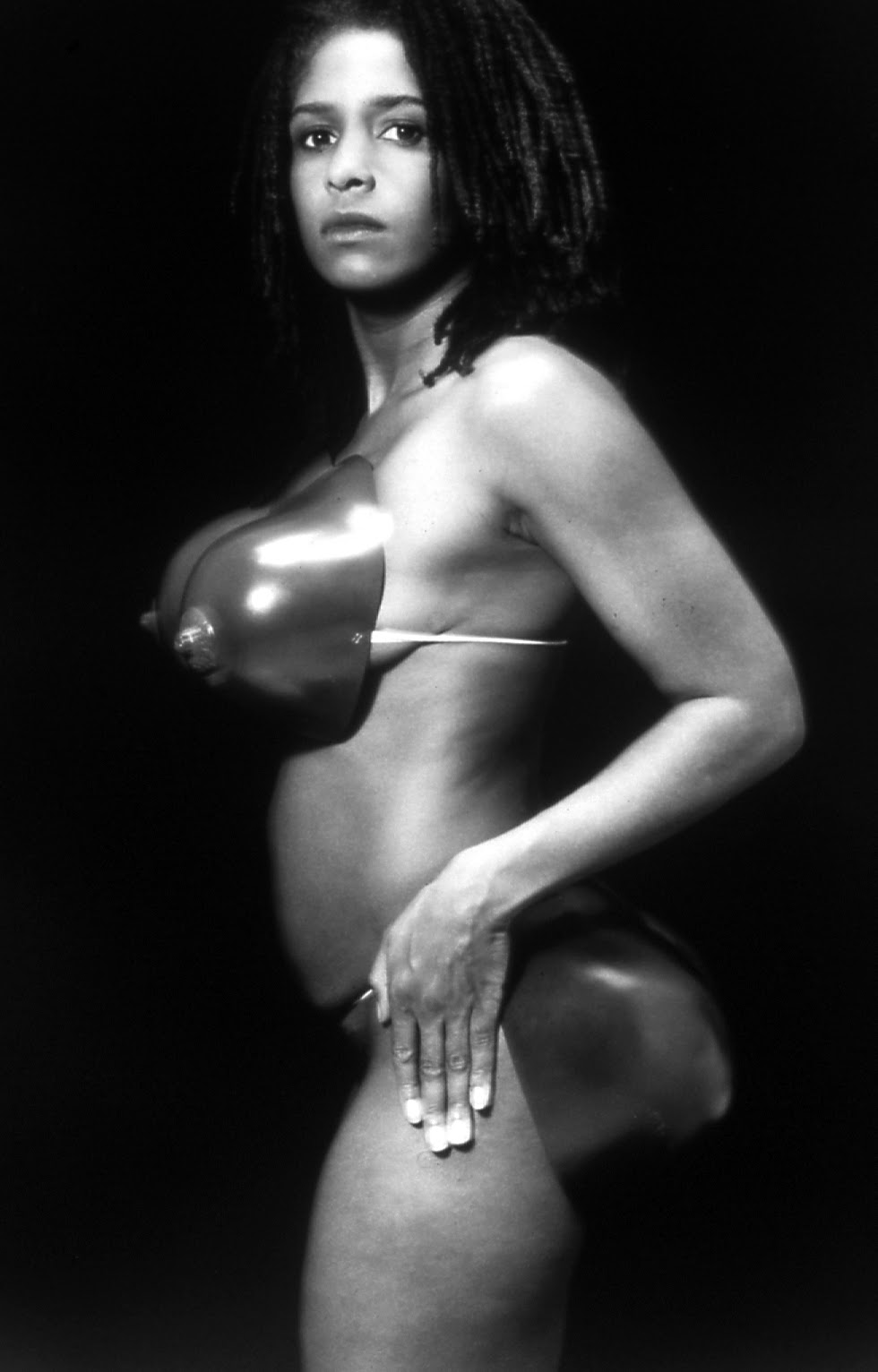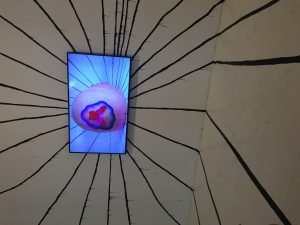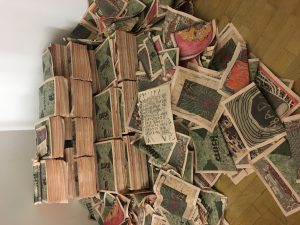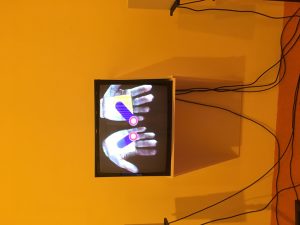This piece was the result of my film project whereby I focused on how mark-making and rhythm coincided with each other; the piece is 4 sheets of A2 in size. I would most likely scale the piece down to A1 and to simplify it, I would stick to the same colour in varying tones and shades. I feel by scaling the piece down, it won’t have such a powerful impact, nor would the individual have had sufficient space to express the emotions they were feeling when reacting to the music they were played. The reason for the various colours was so each layer had an element of the individual’s personality in the piece, so changing the colours to a certain colour scheme, I feel, would take away from the spontaneous and personal elements of the piece since I didn’t know what colour each of them would choose to paint with. Also, using the same colour scheme may mean that all the colours would blend and potentially create quite a bland outcome.
Author Archives: Patricia Odysseos-Suther
Patricia Odysseos-Suther: Task 11
Writing this blog has furthered my interest in Fine Art as a whole and has allowed me to deepen my knowledge in subjects within the Fine Art practice; for example, looking into the history of art and appropriating images.
The task I enjoyed the most was ‘appropriate an image’ as I realised how quickly the meaning behind a piece of work can change and be put into a different context; it also allowed me to bring modern work into a contemporary setting through the use of subject matter that is prevalent in today’s society. I also realise how easy it is to plagiarise someone’s work as, it took me 10 minutes to complete the task.
The task I struggled the most with though was comparing the two texts because, honestly, they were very long, tricky texts to wrap your head around; but, it did teach me to separate relevant information from the rest of text.
Overall, I’ve found this blog helpful when it comes to consolidating my knowledge of the task in hand as they are only brief and force me to only include relevant information.
Patricia Odysseos-Suther: Task 9
The piece I have chosen is ‘Whale’(2009) from Running the Numbers II: Portraits of global mass culture (2009-present) by Chris Jordan and the theory that I will be applying to the piece is James Lovelock’s Gaia Hypothesis.
The piece shows 50,000 plastic bags which is equivalent to the amount of plastic floating in the world’s oceans (1). The way in which this piece relates to Gaia Hypothesis is the idea that we need to look after the earth and in return, the earth will look after us; “If we abuse Gaia, we risk our own survival” as “there is only one pollution…people” – Lovelock (2). Animals aren’t the ones producing plastic bags and discarding them in their own habitats. Everything on this earth needs to work together in order for it to function and Lovelock demonstrates this with his hypothetical scenario ‘Daisy World’ whereby black and white daisies work off each other to grow and keep the planet in a constant equilibrium (2).
Sources:
- http://www.chrisjordan.com/gallery/rtn2/#whale Chris Jordan – Photographic Arts
- ‘Gaia: A New Look at Life on Earth’ – James Lovelock
Patricia Odysseos-Suther: Task 10
- People
- Emotion
- Environment
- Empowerment
- Inclusive
- Scatty
- Welfare
- Loud
- Personal
- Warm
The reason behind my choice in words is that they encapsulate my three main subject matters that I focus on; these being the environment, mental health, and feminism. My work is agent-based and I like to focus on how our environment can alter our well-being both mentally and physically; the attitudes people have towards ‘controversial’ topics can also affect others in some extreme ways and I find this is the case with feminism a lot of the time due to it being such a personal movement. ‘Scatty’, however, is quite a random choice compared to the others, yet it makes complete sense due to the way I work; I hop from one thing to another and I have too many things going on at once. I dislike having a set order to the way I work and the work itself, so the word resonates accurately with me.
(The image is part of my Manifesto project)
Patricia Odysseos-Suther: Task 8
The concept behind the appropriation of this image is to bring it into the 21st Century and relate it to the ever-growing use of screens and modern technology; the main message I am trying to convey is how concerning it is that young children (the millennial generation) are becoming addicted to using screens and social media. The process of appropriating this image felt quite bizarre and the idea of plagiarising someone’s work seemed rather iniquitous; it made me think about how frustrated I would be if someone were to use my work for their own creative gain. On the other hand, part of me feels like that what I have created is considered to be my own work as I have reprocessed and changed the context of the original image by using my own ideas and concepts. However, even if the work has been appropriated, another problem arises whereby people will initially look at the image and recognise it to be the work of the original artist rather than yours.
Image being appropriated: ‘Reflections on The Scream’ (1990) – Roy Lichtenstein
Patricia Odysseos-Suther: Task 7
Leo Steinberg’s (b. 1920) Other Criteria talks about the shift from the Renaissance, to modern and post-modern developed practices. The main point Steinberg discusses in his essay is how the orientation of work can change the meaning of the piece; the main example being the idea of a vertical piece resembling a head-to-toe image in the Renaissance period. He compares works by artists such as Picasso, Rothko, and Newman’s works; they all conform to the ‘head-to-toe’ orientation. He goes on to say that the shift in orientation of the work can radically shift the subject matter of the work, horizontal being more reminiscent of nature, and vertical being the shift to culture. Steinberg finishes off the extract by talking about the work of Rauschenberg during the 1950s which broke out of the standard picture plane of images; Steinberg said that the non-conforming nature of Rauschenberg’s works made them more personable and was a dramatic shift into post-modern art.
Richard Serra’s (b. 1939) The Yale Lecture discusses his practice of site-specific sculpture and the issues that are presented with it. He focusses on transforming traditional processes, such as welding, into the main subject of the work through the use of steel making; combining traditional methods of sculpture with the use of architectural technology, producing Modernist pieces. He focusses on how a piece’s context is majorly affected by the environment it’s placed in. There are a variety of problems with site-specific sculpture; a piece cannot be created in one space and then be transferred to a new location because the piece can be misinterpreted. Serra also says that corporate funded works are often advertised as public service works which detract from the meaning of the piece itself; it is also hard to justify creating such big pieces because they do not allow for secondary sale of the piece.
There are various connections that can be made between the two texts, the main one being the development of each practice from times as far back as the Renaissance to post-modern works; what is also interesting about this point is how the modern/post-modern pieces still have tones of pieces from prior movements, for example, the ‘head-to-toe’ orientation of Renaissance art being transferred to updated works.
Patricia Odysseos-Suther: Task 6
My mode of practice encompasses mark making, combined with the use of filming to create pieces; using the mark making tools and materials as the basis of the piece, and film to finalise and refine it. What I want to document within this mode of practice is the process of creating, looking at each individual mark and the sounds and textures that are made during the process; eventually allowing me to relive the process of my creation in a sensory format. The film making allows me to document this and also, manipulate the footage to create a new piece through modern processes of editing; this would allow abstraction as well as being able to further develop the original piece from a variety of different aspects. The filming process could also allow for different qualities of the filmed piece to be focussed on, like the sounds produced or the textures created. This mode of practice allows for various paths to be explored, from sensory experiences, to the interactive and inclusive nature of the outcomes; it is also applicable to a variety of subject matter and links traditional processes to more contemporary ones.
Patricia Odysseos-Suther: Task 5
Benedict Drew: The Trickle-Down Syndrome
On the 20th August 2017, I visited the Whitechapel Gallery in to view Benedict Drew’s exhibition ‘The Trickle-Down Syndrome’; his works are installation based and are focussed on interactive and sensory experiences. The piece is a five-room installation which encompasses a variety of experiences, from visual, to physically interacting with the piece. Initially, I looked at the work as a group of individual pieces within an exhibition and I didn’t see how they all correlated; however, as I experienced the piece collectively, I began to notice a running theme of surrealism within the piece and senses of emotion throughout the work which you can’t experience without having been there. The piece incorporates a wide range of references, including Busby Berkley’s 1930s stage-sets and Surrealist landscapes by Max Ernst, in order to find where the physical and digital meet. He achieves his outcomes through the use of psychedelic imagery both digitally and physically; Drew used newsprint to exhibit components of the exhibition which hold political value; it’s a powerful and informative medium as it is such an everyday method of spreading information about “the submersion in social and environmental despair” (Benedict Drew). The name of the piece originated from the 1980s phrase for the idea that one day, the wealth and benefits of the rich will hopefully ‘trickle-down’ to the rest of us. Visiting the exhibition rather than viewing images of it really heightened my senses and made me more emotionally invested within the piece due to the nature of his work.
Sources:
http://www.whitechapelgallery.org/exhibitions/benedict-drew/ The Whitechapel Gallery – Benedict Drew
Patricia Odysseos-Suther: Task 4
Exhibition – Soul of a Nation: Art in the Age of Black Power
Soul of a Nation exhibited works from various artists who focussed on the peak of the civil rights movement of 1963. Artists exhibited included Faith Ringgold, Elizabeth Catlett, and Noah Purifoy; the mediums of these works varied from sculpture, paintings, and installations, all expressing the same emotions for a drastic change within American culture. Major figures, such as Martin Luther King Junior and Malcom X were depicted throughout. There were a variety of pieces which captured my attention in this exhibition, for example, ‘American People Series No.20: Die’ by Faith Ringgold which depicts the brutality enforced upon black people by white supremacists during events such as the 1964 Harlem race riot and the 1967 Newark riots. Noah Purifoy’s piece ‘Untitled’ – 1970 (wood, leather, brass, and copper) encompasses traditions from African and Native American societies, as well as wanting to suggest an alternative to the way objects were made in an American capitalist society. The piece uses everyday objects, such as Ghanaian spoons which symbolise fertility dolls that Asante women carry on their backs. Overall, Soul of a Nation encompasses a multitude of interpretations of the Civil Rights movement in a respectful and powerful manor; each artist had their own space to flourish regardless of the medium in which they worked in. There was also a nice variety of types of work within the exhibition, rather than solely exhibiting one practice.
Patricia Odysseos-Suther: Task 3
Renée Cox – Hot-en-tot Venus (1994)
‘Hot-en-tot Venus’ shows a black woman posing with her back arched, facing the camera, and has augmented breasts and rear attached to her; the image has then been rendered black and white. I believe that the piece is making a feminist statement about black women and how they’re stereotype in terms of looks. The woman is evidently arching her back to emphasise the point being made. The expression on her face comes across as sombre and melancholy, showing how stereotyping can affect someone about features they can’t change.
The context behind the piece actually begins with Cox herself, posing as the figure in the piece to redefine herself as a black woman while at the same time, representing other women who share similar situations. In this piece, we see how the female form is celebrated and appraised. The negative side of the image is the way in which the portrayal of black women is highly criticised and sexualised within the media. Nonetheless, the celebration comes through her embracing her nude stance; thus, being able to communicate to other women around the globe that our bodies are nothing to be ashamed of and that being nude is an empowering stance to take.
The image communicates a feeling of unity between all women in terms of being able to express ourselves through our bodies without having to be sexualised to have validation from society; I believe this to be a message that can be shared internationally with all women, regardless of race or circumstances because we all experience stereotyping to a degree. However, I do believe that the way black women are portrayed and sexualised in the media is a point which is international as well because there are black women all over the world who may have come across the ignorant stereotyping.
Sources:
https://artintheblackdiaspora.wordpress.com/2014/05/01/renee-cox-hot-en-tot/ Black Feminist Art



